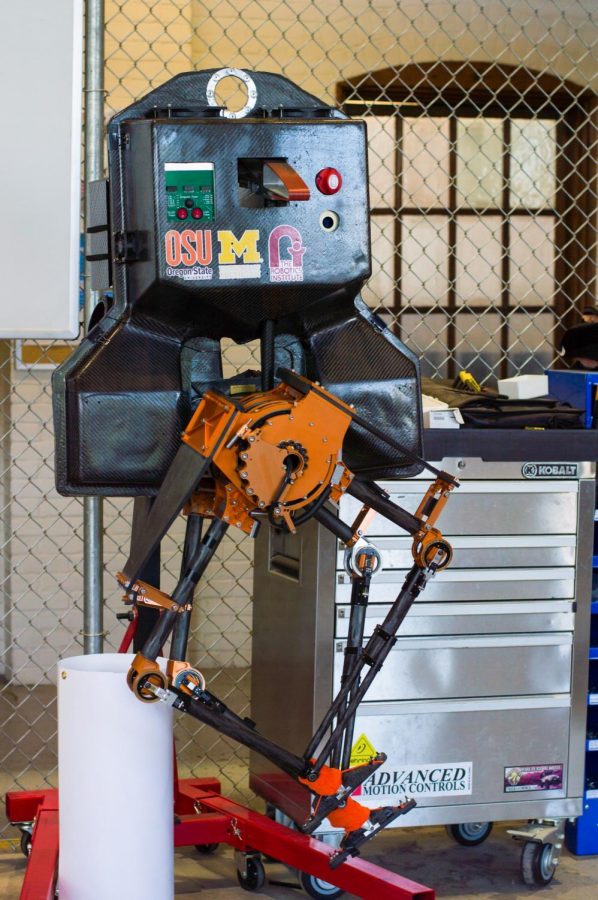Door to door robot delivery
May 19, 2016
Agility Robotics, OSU robotics program receives funds for robot design
For Jonathan Hurst, UPS workers will not be rushing from door to door to deliver packages in the near future. Instead, UPS workers will be replaced with something more efficient—robots.
Hurst, associate professor of mechanical engineering and College of Engineering Dean’s Professor, co-founded the company Agility Robotics in order to design and create robots used for automated delivery and distribution systems with technology licensed from Oregon State University.
Agility Robotics won the top prize at the 2016 Willamette Angel Conference last Thursday, receiving $100,000 in investment funding to help finance Agility Robotics’ work on automated delivery systems.
The Willamette Angel Conference pulls investment money from a collection of investors throughout the Willamette Valley, and invites local technology companies to compete for the funding. The conference began with over forty companies, and was slowly narrowed down to five finalists. The top three companies, including Agility Robotics, split the prize money, each receiving $100,000.
Agility Robotics will use this money towards funding their ongoing project—designing robots that are able to deliver packages directly to front doors, according to Hurst.
“Imagine a package delivery system from FedEx or Amazon that is completely autonomous,” Hurst said. “How do you get the package from the truck to the doorstep? That’s where we come in, and that’s where we can build legs to be able to do that.”
This new form of package delivery will work towards making distribution of packages more efficient and driving down the prices in the long run, according to Hurst.
“The thing that is really exciting is that it makes delivery and distribution automated, and thus, cheap,” Hurst said. “At some point, you will be able to order something and in half an hour it’s at your house.”
This efficiency will work to change the entire market system and ultimately the economy, according to Hurst.
“This will really change the way people buy things. It has the potential to have a huge impact on our economy and make everything better,” Hurst said. “That’s what we’re trying to do—make the world better.”
Currently Graf Hall in the OSU campus houses Agility Robotics’ fully-functioning demonstration robot named Cassie. Coded and refined by OSU students, Cassie is often taken on walks throughout McDonald forest to test balance. Although Cassie can use legs to walk on different terrains, Agility Robotics is working on plans for improvement, according to Hurst.
“We are going to mount a series of small cameras on the robot to build a complete 3D model of the world around it,” Hurst said. “You will be able to put on goggles and turn your head to look anywhere in the world the robot sees. It’s very much like a first-person video game, except you are controlling the robot in the real world.”
This continuous process of refining Cassie brings Agility Robotics one step closer to the company’s future goals, which extends into other facets of human life, according to co-founder of Agility Robotics Mikhail Jones.
“Our big goal is to build robots that can interact and go into human environments. There are several instances where you don’t want to send in a human, such as search and rescue,” Jones said.
“If you have a burning building and aren’t sure if people are still inside, do you send in a robot or a firefighter? Of course the robot will initially cost more money, but overall that would be an easy call to make.”
Agility Robotics hopes to extend its technology into the military, providing soldiers with a map of the terrain without putting them in harm’s way first. Agility Robotics is also working towards designing prostheses, according to James.
“If we continue to design and build our robotic systems to work efficiently, this will open doors to designing prosthetic legs,” James said.
Along with broad-reaching implications, Agility Robotics is working towards benefiting OSU students and Corvallis community members as well, according to co-founder Damion Shelton.
“The robotics program at OSU is unique in its strong emphasis on mechanical engineering, as opposed to the computer science focused programs found at many other universities,” Shelton said. “This makes Corvallis an ideal location for a robotics startup.”
Through the funding received from the Willamette Angel Conference, Agility Robotics hopes to eventually spur drastic improvements throughout society as a whole, according to Hurst.
“We are kind of in the middle of something like the Industrial Revolution right now,” Hurst said. “There are an awful lot of jobs that don’t exist anymore because of it, but our quality of life across the board is significantly better than it ever was. That’s what this is going to do, too—across the board—the quality of life is going to continue to improve.”











































































































